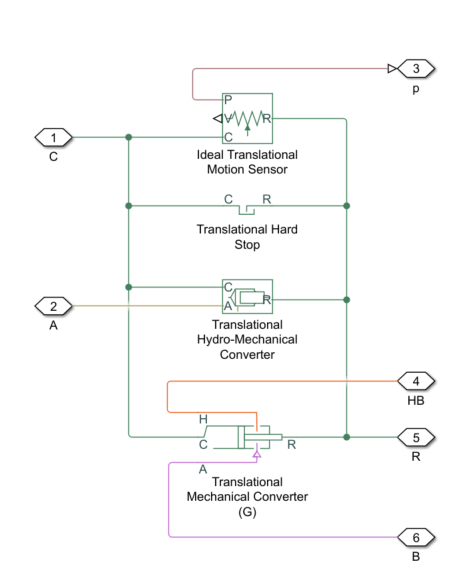Double-Acting Actuator (H-G)
(Not recommended) Linear actuator with opposing isothermal liquid and gas chambers
The Hydraulics (Isothermal) library will be removed in a future release. Use the Isothermal Liquid library instead.
For more information on updating your models, see Upgrading Hydraulic Models to Use Isothermal Liquid Blocks.
Libraries:
Simscape /
Fluids /
Hydraulics (Isothermal) /
Valves /
Valve Actuators
Description
The Double-Acting Actuator (H-G) block represents a linear actuator with opposing chambers of isothermal liquid and gas. The chambers can be individually pressurized to power the actuator in both the extension and retraction strokes. A piston between the chambers converts the pressure difference across them into actuation force.
The figure maps the conserving ports of the block to the actuator parts. Ports A and B are the inlets of the isothermal liquid and gas chambers. Ports R and C are the translating piston and case. The gas chamber can exchange heat with the environment and is fitted for this purpose with port H. The isothermal liquid, being of constant temperature, exchanges heat neither with the environment nor with the gas across the piston.

The sign of the piston displacement relative to the case depends on the mechanical orientation of the actuator. Use the Mechanical orientation parameter to specify this setting. If the mechanical orientation is positive, the piston displacement is positive when the pressure is highest in the isothermal liquid chamber (port A). If the mechanical orientation is negative, the piston displacement (under the same pressure conditions) is negative.
Use port P to output the instantaneous piston position. The position measurement can be absolute or relative. Configure the Piston position display parameter to switch the measurement type if needed:
From piston initial distance from port A— The measurement is absolute. The first reading is the value specified in the Piston initial distance from port A. If that value is10 in, the first reading is also10 in.From zero— The measurement is relative to the initial piston position. The first reading, as it corresponds to the initial piston position, is zero.
Hard stops limit the motion of the piston to the length of the case. The stops are modeled as spring-dampers, with spring and damping coefficients to capture material compliance. One is located at the bottom of the piston stroke and the other at the top:
If the Mechanical orientation setting is
Positive, the bottom stop is at zero, and the top stop is at a distance equal to the piston stroke.If the Mechanical orientation setting is
Negative, the top stop is at zero, and the bottom stop is at a distance equal to the piston stroke.
The block is a composite component built from Simscape™ Foundation blocks. For more information on how the Double-Acting Actuator (H-G) block works, see the reference pages of the constituent blocks:

